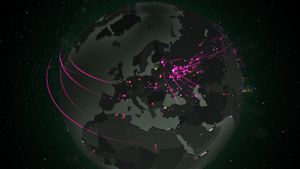JAKARTA - NASA's Juno spacecraft has just captured a stunning image of giant Jupiter and its shadowy moon, Ganymede.
When this image was taken, Juno was shooting near the planet for the 40th time on February 25, at a distance of about 44,000 miles (71,000 kilometers) above Jupiter's cloud tops, which is about 15 times closer than Ganymede's 666,000 orbital distance. miles (1.1 million kilometers).
With that, resident scientist Thomas Thomopoulos created an enhanced color image using raw data based on what was gathered from the JunoCam instrument.
According to NASA, if scientists were at the top of Jupiter's clouds in an oval shadow, they could witness a total solar eclipse. Since Ganymede is a large Moon, total eclipses are a common occurrence on Jupiter compared to planet Earth.
Ganymede is even bigger than the planet Mercury. It is the only Moon known to have a magnetic field of its own, resulting in the aurora circling the lunar poles.
NASA says there is evidence to suggest Ganymede may be hiding a sea of liquid water beneath its icy surface. Scientists also believe the planet's oceans have more water than all the water on Earth's surface.
Launching Space, Monday, April 25, in addition, Jupiter also has four main moons that often pass between Jupiter and the Sun. In the span of seven days, Ganymede transited once, Europa twice, and Io four times.
Jupiter's moons orbit in a plane close to the giant planet's orbital plane, so the moon's shadow is more frequently seen on the planet.
SEE ALSO:
Junocam was able to shoot this image at close range to Jupiter, which makes Ganymede's shadow appear larger than before.
Previously, Juno was indeed on a long-term mission to understand the weather and dynamics of Jupiter, the largest planet in the Solar System. Studying this planet up close will also allow scientists to find out how large exoplanets in other Solar Systems behave.
However, NASA said Juno remains in good health amid the extended mission later, but will have a limited lifespan due to the amount of radiation it encounters.
Even so, space scientists have big plans for Jupiter's moons in the 2030s, including visits from NASA's Europa Clipper and the European Space Agency's (ESA) Jupiter Icy Moons Explorer.
The English, Chinese, Japanese, Arabic, and French versions are automatically generated by the AI. So there may still be inaccuracies in translating, please always see Indonesian as our main language. (system supported by DigitalSiber.id)















